
The RBMK is a class of graphite-moderated nuclear power reactor designed and built by the Soviet Union. It is somewhat like a boiling water reactor as water boils in the pressure tubes. It is one of two power reactor types to enter serial production in the Soviet Union during the 1970s, the other being the VVER reactor. The name refers to its design where instead of a large steel pressure vessel surrounding the entire core, the core is surrounded by a cylindrical annular steel tank inside a concrete vault and each fuel assembly is enclosed in an individual 8 cm (inner) diameter pipe. The channels also contain the coolant, and are surrounded by graphite.
The Monticello Nuclear Generating Plant is a nuclear power plant located in Monticello, Minnesota, along the Mississippi River. The site, which began operating in 1971, has a single nuclear reactor of the General Electric BWR-3 design generating 671 MWe. The plant is owned by Xcel Energy and operated by Northern States Power, its regional subsidiary.
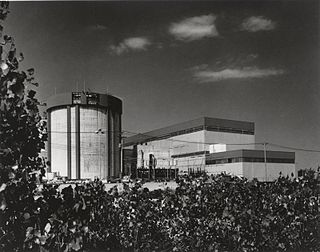
Zion Nuclear Power Station was the third dual-reactor nuclear power plant in the Commonwealth Edison (ComEd) network and served Chicago and the northern quarter of Illinois. The plant was built in 1973, and the first unit started producing power in December 1973. The second unit came online in September 1974. This power generating station is located on 257 acres (104 ha) of Lake Michigan shoreline, in the city of Zion, Lake County, Illinois. It is approximately 40 direct-line miles north of Chicago, Illinois and 42 miles (68 km) south of Milwaukee, Wisconsin.

The Enrico Fermi Nuclear Generating Station is a nuclear power plant on the shore of Lake Erie near Monroe, in Frenchtown Charter Township, Michigan on approximately 1,000 acres (400 ha). All units of the plant are operated by the DTE Energy Electric Company and owned by parent company DTE Energy. It is approximately halfway between Detroit, Michigan, and Toledo, Ohio. It is also visible from parts of Amherstburg and Colchester, Ontario as well as on the shore of Lake Erie in Ottawa County, Ohio. Two units have been constructed on this site. The first unit's construction started on August 4, 1956 and reached initial criticality on August 23, 1963, and the second unit received its construction permit on September 26, 1972. It reached criticality on June 21, 1985 and was declared commercial on November 18, 1988. The plant is connected to two single-circuit 345 kV Transmission Lines and three 120 kV lines. They are operated and maintained by ITC Transmission.

A nuclear power phase-out is the discontinuation of usage of nuclear power for energy production. Often initiated because of concerns about nuclear power, phase-outs usually include shutting down nuclear power plants and looking towards fossil fuels and renewable energy. Three nuclear accidents have influenced the discontinuation of nuclear power: the 1979 Three Mile Island partial nuclear meltdown in the United States, the 1986 Chernobyl disaster in the USSR, and the 2011 Fukushima nuclear disaster in Japan.
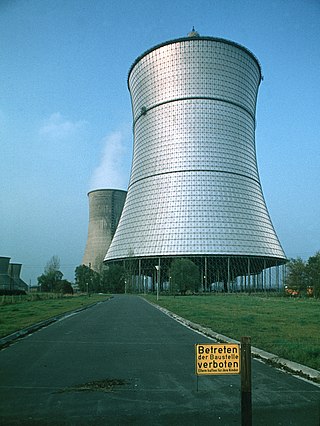
The THTR-300 was a thorium cycle high-temperature nuclear reactor rated at 300 MW electric (THTR-300) in Hamm-Uentrop, Germany. It started operating in 1983, synchronized with the grid in 1985, operated at full power in February 1987 and was shut down September 1, 1989. The THTR-300 served as a prototype high-temperature reactor (HTR) to use the TRISO pebble fuel produced by the AVR, an experimental pebble bed operated by VEW. The THTR-300 cost €2.05 billion and was predicted to cost an additional €425 million through December 2009 in decommissioning and other associated costs. The German state of North Rhine Westphalia, Federal Republic of Germany, and Hochtemperatur-Kernkraftwerk GmbH (HKG) financed the THTR-300’s construction.
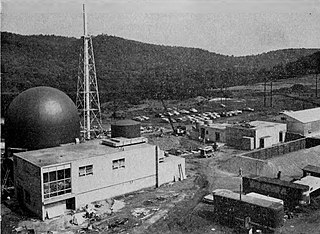
The Saxton Nuclear Experiment Station, also known as the Saxton Nuclear Generating Station or Saxton Nuclear Experimental Corporation Facility, was a small nuclear power plant located in Bedford County, near Saxton, Pennsylvania.

Isar I and Isar II were two nuclear power plants situated on the Isar river, 14 kilometres from Landshut, between Essenbach and Niederaichbach in Bavaria, Germany.

Nuclear power was used in Germany from the 1960s until it was fully phased out in April 2023.
Nuclear power in Switzerland is generated by three nuclear power plants, with a total of four operational reactors (see list below). Since 1985, nuclear power has been contributing approximately 40% of Switzerland's electrical energy. In 2022, it produced 23 terawatt-hours (TWh) of electricity, and accounted for 37% of the nation's gross electricity generation of 62 TWh, while 55% was produced by hydroelectric plants and 8% came from conventional thermal power stations and non-hydro renewable energy sources.

The Tōkai Nuclear Power Plant was Japan's first commercial nuclear power plant. The first unit was built in the early 1960s to the British Magnox design, and generated power from 1966 until it was decommissioned in 1998. A second unit, built at the site in the 1970s, was the first in Japan to produce over 1000 MW of electricity. The site is located in Tokai in the Naka District in Ibaraki Prefecture, Japan and is operated by the Japan Atomic Power Company. The total site area amounts to 0.76 km2 with 0.33 km2, or 43% of it, being green area that the company is working to preserve.

The Sendai Nuclear Power Plant is a nuclear power plant located in the city of Satsumasendai in Kagoshima Prefecture. The two 846 MW net reactors are owned and operated by the Kyūshū Electric Power Company. The plant, like all other nuclear power plants in Japan, did not generate electricity after the nationwide shutdown in the wake of the Fukushima Daiichi nuclear disaster in 2011, but was restarted on August 11, 2015, and began providing power to nearby towns again. Sendai is the first of Japan's nuclear power plants to be restarted.
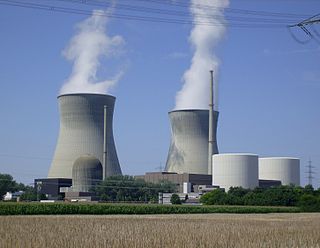
The Gundremmingen Nuclear Power Plant was a nuclear power station in Germany. It was located in Gundremmingen, district of Günzburg, Bavaria. It was operated by Kernkraftwerk Gundremmingen GmbH, a joint operation of RWE Power AG (75%) and PreussenElektra (25%). Unit B was shut down at the end of 2017. Unit C, the last boiling water reactor in Germany, was shut down on New Year's Eve 2021, as part of the German nuclear phase out. However, Gundremmingen unit C as well as the other two German nuclear reactors shut down that day remained capable of restarting operations in March 2022. In November 1975, Unit A was the site of the first fatal accident in a nuclear power plant in Germany, though the accident was unrelated to radiation. After a later major incident in 1977, Unit A was never returned to service.
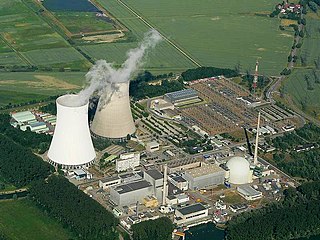
The Philippsburg Nuclear Power Plant is located in Philippsburg, Karlsruhe (district), Germany. The plant was operated by EnBW Kernkraft GmbH. As part of Germany's phase out of nuclear energy (Atomausstieg), unit 1 was shut down in 2011 and unit 2 in 2019. Demolition of conventional structures began in January 2020. The process of decommissioning is underway as of January 2020 beginning with defueling and dismantling of primary coolant lines. The plants operator EnBW expects the decommissioning process to take around 10-15 years.
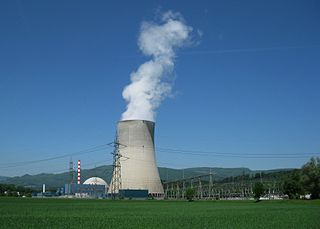
The Gösgen Nuclear Power Plant is located in the Däniken municipality on a loop of the Aar river. It is operated by the ad hoc society Kernkraftwerk Gösgen-Däniken AG.
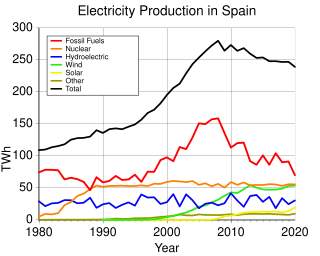
Spain has five active nuclear power plants with seven reactors producing 20% of the country's electricity as of 2023.

Obrigheim Nuclear Power Plant (KWO) is a nuclear power plant currently in the decommissioning phase. The plant is located in Obrigheim, Neckar-Odenwald-Kreis, on the banks of the Neckar and owned by EnBW. It operated a pressurized water reactor unit from 1969 to 2005. The defuelling process was completed in 2007, with spent fuel rods awaiting transport to an interim storage facility. In March 2017, EnBW tested the shipment of numerous castors by a barge on the Neckar to Neckarwestheim Nuclear Power Plant.
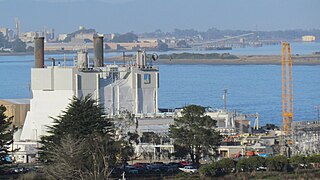
The Humboldt Bay Power Plant, Unit 3 was a 63 MWe nuclear boiling water reactor, owned by Pacific Gas and Electric Company that operated from August 1963 to July 1976 just south of Eureka, California, in an area referred to as King Salmon and Fields Landing.
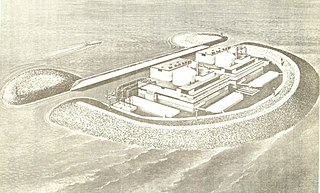
Offshore Power Systems (OPS) was a 1970 joint venture between Westinghouse Electric Company, which constructed nuclear generating plants, and Newport News Shipbuilding and Drydock, which had recently merged with Tenneco, to create floating nuclear power plants at Jacksonville, Florida.
National nuclear energy policy is a national policy concerning some or all aspects of nuclear energy, such as mining for nuclear fuel, extraction and processing of nuclear fuel from the ore, generating electricity by nuclear power, enriching and storing spent nuclear fuel and nuclear fuel reprocessing. Nuclear energy policies often include the regulation of energy use and standards relating to the nuclear fuel cycle.




















